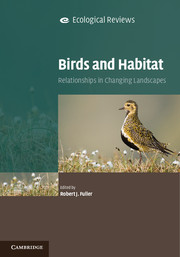Book contents
- Frontmatter
- Contents
- List of Contributors
- Preface
- Part I The complexity of patterns and processes
- Part II Case studies of habitat use and selection
- Part III Wider perspectives
- Chapter Fifteen What is habitat quality? Dissecting a research portfolio on shorebirds
- Chapter Sixteen Understanding individual life-histories and habitat choices: implications for explaining population patterns and processes
- Chapter Seventeen Insufficient adaptation to climate change alters avian habitat quality and thereby changes habitat selection
- Chapter Eighteen Australian birds in a changing landscape: 220 years of European colonisation
- Chapter Nineteen Birds in cultural landscapes: actual and perceived differences between northeastern North America and western Europe
- Chapter Twenty Birds and their changing habitat: thoughts on research and conservation strategies
- Species index
- Subject index
- References
Chapter Seventeen - Insufficient adaptation to climate change alters avian habitat quality and thereby changes habitat selection
Published online by Cambridge University Press: 05 December 2012
- Frontmatter
- Contents
- List of Contributors
- Preface
- Part I The complexity of patterns and processes
- Part II Case studies of habitat use and selection
- Part III Wider perspectives
- Chapter Fifteen What is habitat quality? Dissecting a research portfolio on shorebirds
- Chapter Sixteen Understanding individual life-histories and habitat choices: implications for explaining population patterns and processes
- Chapter Seventeen Insufficient adaptation to climate change alters avian habitat quality and thereby changes habitat selection
- Chapter Eighteen Australian birds in a changing landscape: 220 years of European colonisation
- Chapter Nineteen Birds in cultural landscapes: actual and perceived differences between northeastern North America and western Europe
- Chapter Twenty Birds and their changing habitat: thoughts on research and conservation strategies
- Species index
- Subject index
- References
Summary
Before approaching the main theme of this chapter I want to start with some intriguing field observations that, by accident, set me on the track of investigating the effects of climate change on avian ecology. Checking nest-boxes is like having a birthday party: opening boxes is always a surprise. While tramping from box to box, my mind works in overdrive to find patterns. One such pattern that started to fascinate me was that pied flycatchers Ficedula hypoleuca seem to prefer nest-boxes occupied by tits. Flycatchers are long-distance migrants that normally arrive when the tits already have started nest-building, and often have started egg-laying as well. Upon the flycatcher’s arrival, many boxes are still empty, whereas others are occupied by various tit species. Still, flycatchers consistently prefer the boxes containing nest material of tits. I have recorded this pattern over many years and in several areas (unpublished data), so I truly believe this pattern is real. This is not just a minor fact of life, but a potentially deadly adventure for a pied flycatcher. Each year we find – mostly male – flycatchers killed in nest-boxes, and often these nest-boxes had been occupied by great tits Parus major (Slagsvold, 1975; Ahola et al., 2007). It occasionally happens that great tits are incubating on extremely smelly nests, because a decomposing pied flycatcher had been included in the nest material. A closer look at the killed flycatchers further reveals that – more often than not – the brain has been eaten, a high-energy meal for an egg-laying bird early in the season. The attraction of already occupied nest-boxes for arriving pied flycatchers must have an enormous advantage, given its frequency and potentially lethal outcome.
- Type
- Chapter
- Information
- Birds and HabitatRelationships in Changing Landscapes, pp. 432 - 452Publisher: Cambridge University PressPrint publication year: 2012
References
- 1
- Cited by

